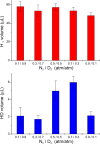Mechanism of N2 Reduction Catalyzed by Fe-Nitrogenase Involves Reductive Elimination of H2
- PMID: 29283553
- PMCID: PMC5837051
- DOI: 10.1021/acs.biochem.7b01142
Mechanism of N2 Reduction Catalyzed by Fe-Nitrogenase Involves Reductive Elimination of H2
Abstract
Of the three forms of nitrogenase (Mo-nitrogenase, V-nitrogenase, and Fe-nitrogenase), Fe-nitrogenase has the poorest ratio of N2 reduction relative to H2 evolution. Recent work on the Mo-nitrogenase has revealed that reductive elimination of two bridging Fe-H-Fe hydrides on the active site FeMo-cofactor to yield H2 is a key feature in the N2 reduction mechanism. The N2 reduction mechanism for the Fe-nitrogenase active site FeFe-cofactor was unknown. Here, we have purified both component proteins of the Fe-nitrogenase system, the electron-delivery Fe protein (AnfH) plus the catalytic FeFe protein (AnfDGK), and established its mechanism of N2 reduction. Inductively coupled plasma optical emission spectroscopy and mass spectrometry show that the FeFe protein component does not contain significant amounts of Mo or V, thus ruling out a requirement of these metals for N2 reduction. The fully functioning Fe-nitrogenase system was found to have specific activities for N2 reduction (1 atm) of 181 ± 5 nmol NH3 min-1 mg-1 FeFe protein, for proton reduction (in the absence of N2) of 1085 ± 41 nmol H2 min-1 mg-1 FeFe protein, and for acetylene reduction (0.3 atm) of 306 ± 3 nmol C2H4 min-1 mg-1 FeFe protein. Under turnover conditions, N2 reduction is inhibited by H2 and the enzyme catalyzes the formation of HD when presented with N2 and D2. These observations are explained by the accumulation of four reducing equivalents as two metal-bound hydrides and two protons at the FeFe-cofactor, with activation for N2 reduction occurring by reductive elimination of H2.
Conflict of interest statement
The authors declare no competing financial interest.
Figures







Similar articles
-
Mo-, V-, and Fe-Nitrogenases Use a Universal Eight-Electron Reductive-Elimination Mechanism To Achieve N2 Reduction.Biochemistry. 2019 Jul 30;58(30):3293-3301. doi: 10.1021/acs.biochem.9b00468. Epub 2019 Jul 19. Biochemistry. 2019. PMID: 31283201
-
Effects on substrate reduction of substitution of histidine-195 by glutamine in the alpha-subunit of the MoFe protein of Azotobacter vinelandii nitrogenase.Biochemistry. 1998 Dec 15;37(50):17495-505. doi: 10.1021/bi9812017. Biochemistry. 1998. PMID: 9860864
-
Kinetic Understanding of N2 Reduction versus H2 Evolution at the E4(4H) Janus State in the Three Nitrogenases.Biochemistry. 2018 Oct 2;57(39):5706-5714. doi: 10.1021/acs.biochem.8b00784. Epub 2018 Sep 19. Biochemistry. 2018. PMID: 30183278 Free PMC article.
-
Biosynthesis of the Metalloclusters of Nitrogenases.Annu Rev Biochem. 2016 Jun 2;85:455-83. doi: 10.1146/annurev-biochem-060614-034108. Epub 2016 Feb 1. Annu Rev Biochem. 2016. PMID: 26844394 Review.
-
Structure and mechanism of catalytic action of active sites of nitrogenase.Biol Bull Acad Sci USSR. 1978 Mar-Apr;5(2):125-42. Biol Bull Acad Sci USSR. 1978. PMID: 154348 Review.
Cited by
-
Hydrogenase and Nitrogenase: Key Catalysts in Biohydrogen Production.Molecules. 2023 Feb 1;28(3):1392. doi: 10.3390/molecules28031392. Molecules. 2023. PMID: 36771068 Free PMC article. Review.
-
The Spectroscopy of Nitrogenases.Chem Rev. 2020 Jun 24;120(12):5005-5081. doi: 10.1021/acs.chemrev.9b00650. Epub 2020 Apr 2. Chem Rev. 2020. PMID: 32237739 Free PMC article. Review.
-
Metabolic Model of the Nitrogen-Fixing Obligate Aerobe Azotobacter vinelandii Predicts Its Adaptation to Oxygen Concentration and Metal Availability.mBio. 2021 Dec 21;12(6):e0259321. doi: 10.1128/mBio.02593-21. Epub 2021 Dec 14. mBio. 2021. PMID: 34903060 Free PMC article.
-
Nitrogen Fixation and Hydrogen Evolution by Sterically Encumbered Mo-Nitrogenase.JACS Au. 2023 May 9;3(5):1521-1533. doi: 10.1021/jacsau.3c00165. eCollection 2023 May 22. JACS Au. 2023. PMID: 37234119 Free PMC article.
-
Exploiting Biological Nitrogen Fixation: A Route Towards a Sustainable Agriculture.Plants (Basel). 2020 Aug 11;9(8):1011. doi: 10.3390/plants9081011. Plants (Basel). 2020. PMID: 32796519 Free PMC article. Review.
References
-
- Raymond J, Siefert JL, Staples CR, Blankenship RE. The natural history of nitrogen fixation. Mol. Biol. Evol. 2004;21:541–554. - PubMed
-
- Burris RH, Roberts GP. Biological nitrogen fixation. Annu. Rev. Nutr. 1993;13:317–35. - PubMed
-
- Gruber N, Galloway JN. An Earth-system perspective of the global nitrogen cycle. Nature. 2008;451:293–296. - PubMed
-
- Eady RR. Structure-function relationships of alternative nitrogenases. Chem. Rev. 1996;96:3013–3030. - PubMed
-
- Burgess BK, Lowe DJ. Mechanism of molybdenum nitrogenase. Chem. Rev. 1996;96:2983–3012. - PubMed
Publication types
MeSH terms
Substances
Grants and funding
LinkOut - more resources
Full Text Sources
Other Literature Sources
Research Materials
Miscellaneous

